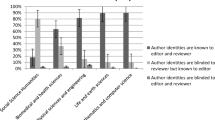Abstract
The scientific quality of the academic journal deeply relies on its peer review policy which may be guided by some cheap talk statement. However, some of these policies may fail to get executed by editors who are responsible for the processing of contributions. In this paper, the peer review strategy is defined as the smallest set of editorial decisions to optimally guide the other manuscript decisions. The chief formulates this review strategy by choosing those strategic editorial decisions optimally and having other editorial decisions align with them in the quality of collected reviews. In this process, a quality-assurance editor is in charge of the evaluation of the alignment quality of reviewer reports with each other review process. This policy thus ensures that all final decisions fit together since editors’ choices align on the announced strategic decisions. Here, we present an automatic tool, called ‘STRATEGY’, for the formulation of such peer-review strategies. Several examples illustrate the performance of the STRATEGY tool.







Similar content being viewed by others
References
Adams, Nancy H. (1999). Quality assurance reviews: How they differ from peer reviews. Quality Assurance, 6(2), 75–85. doi:10.1080/105294199277879.
Brilis, G. M., & Lyon, J. G. (2005). Peer review as a QA tool in environmental applications. Quality Assurance, 11(2–4), 111–129.
Edwards, M. T. (2009). Peer review: A new tool for quality improvement. Physician executive, 35(5), 54–59.
Farrell, J., & Rabin, M. (1996). Cheap Talk. Journal of Economic Perspectives, 10(3), 103–118.
Garcia, J. A., Rodriguez-Sanchez, R., & Fdez-Valdivia, J. (2016). Authors and reviewers who suffer from confirmatory bias. Scientometrics, 109(2), 1377–1395. doi:10.1007/s11192-016-2079-y.
Hughes, T. J. (2010). Quality science and quality assurance: Observations of an environmental scientist. Quality Assurance, 7(4), 225–235.
ISO 9000. (2015). http://www.iso.org/iso/home/standards/management-standards/iso_9000.htm.
McAfee, R. Preston. (2010). Edifying editing. The American Economist, 55(1), 1–8.
Tukey, J. W. (1977). Exploratory data analysis. Addison-Wesley. ISBN 0-201-07616-0. OCLC 3058187.
Van den Steen, E. (2013). A formal theory of strategy. Harvard Business School Strategy Unit Working Paper No. 14-058. doi:10.2139/ssrn.2383981.
Acknowledgements
This research was sponsored by the Spanish Board for Science, Technology, and Innovation under grant TIN2013-41585-P, cofinanced with European FEDER funds. Sincere thanks are due to the reviewers for their constructive suggestions.
Author information
Authors and Affiliations
Corresponding author
Rights and permissions
About this article
Cite this article
García, J.A., Rodriguez-Sánchez, R. & Fdez-Valdivia, J. STRATEGY: a tool for the formulation of peer-review strategies. Scientometrics 113, 45–60 (2017). https://doi.org/10.1007/s11192-017-2470-3
Received:
Published:
Issue Date:
DOI: https://doi.org/10.1007/s11192-017-2470-3




